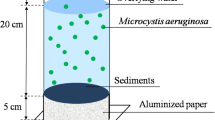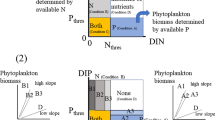Abstract
Concentrations of lipid-phosphorus (LP) in aquatic ecosystems can be influenced by algal biomass and the nutritional state of microbial communities, potentially serving a useful indicator of P-limitation. We examined the effectiveness of LP as a bioindicator by examining concentrations of LP and environmental factors controlling its abundance across Lake Erie and its tributaries. LP concentrations were correlated with chlorophyll a (Chl a) and total suspended solids, total P, and particulate carbon (PC), nitrogen, and P (PP) in both river and lake waters, while dissolved nutrients were only related to lake LP concentrations. Tributary LP was generally higher than in-lake values, and stoichiometric relationships between PC, PP, and LP indicated that Chl a was correlated with tributary LP. Chl a, bacterial production, and LP concentrations decreased significantly across nutrient gradients going from the west to east across the lake. Consistent relationships between lake particulate C:P ratios and Chl a: LP ratios were found across seasons, and higher values of both in August suggested algal P-limitation during this period. To further explore environmental controls on LP, we compared the relative influence of temperature, phytoplankton taxonomy, and water chemistry on lake LP concentrations. Though LP was correlated with well-known factors associated with cyanobacterial abundance in the lake (temperature and ammonium), particulate biomass and algal P-limitation seemed to be the most important correlates of LP concentration, suggesting that Chl a:LP ratios could provide a metric of P-limitation in aquatic ecosystems.






Similar content being viewed by others
Data availability
The datasets generated and/or analyzed during the current study are available from figshare. https://doi.org/10.6084/m9.figshare.14525484.
References
Allinger LE, Reavie ED (2013) The ecological history of Lake Erie as recorded by the phytoplankton community. J Great Lakes Res 39:365–382
APHA (1992) APHA Method 3500-MG: Standard methods for the examination of water and wastewater, 18th ed. American Public Health Association, Washington D.C.
Bellinger BJ, Van Mooy BAS (2012) Nonphosphorus lipids in periphyton reflect available nutrients in the Florida Everglades, USA. J Phycol 48:303–311
Bellinger BJ, Van Mooy BAS, Cotner JB, Fredricks HF (2014) Physiological modifications of seston in response to physicochemical gradients within Lake Superior. Limnol Oceanogr 59:1011–1026
Carlson RE (1977) A trophic state index for lakes. Limnol Oceanogr 22(2):361–369. https://doi.org/10.4319/lo.1977.22.2.0361
Chaffin JD, Bridgeman TB, Heckathorn SA, Mishra S (2011) Assessment of Microcystis growth rate potential and nutrient status across a trophic gradient in western Lake Erie. J Great Lakes Res 37:92–100
Chaffin JD, Bridgeman TB, Bade DL, Mobilian CN (2014) Summer phytoplankton nutrient limitation in Maumee Bay of Lake Erie during high-flow and low-flow years. J Great Lakes Res 40(3):524–531
Chomicki KM, Howell ET, Defield E, Dumas A (2016) Factors influencing the phosphorus distribution near the mouth of the Grand River, Ontario. Lake Erie J Great Lakes Res 42(3):549–564
Conroy JD, Kane DD, Dolan DM, Edwards WJ (2005) Temporal trends in Lake Erie plankton biomass: roles of external phosphorus loading and dreissenid mussels. J Great Lakes Res 31:89–110
Conroy JD, Kane DD, Briland RD, Culver DA (2014) Systemic, early-season Microcystis blooms in western Lake Erie and two of its major agricultural tributaries (Maumee and Sandusky rivers). J Great Lakes Res 40:518–523
DePinto JV, Young TC, McIlroy LM (1986) Great Lakes water quality improvement: The strategy of phosphorus discharge control is evaluated. Environ Sci Technol 20:752–759
Dolan DM (1993) Point source loadings of phosphorus to lake erie: 1986–1990. J Great Lakes Res 19:212–223
Dove A, Chapra CS (2015) Long-term trends of nutrients and trophic response variables for the Great Lakes. Limnol Oceanogr 60(2):696–721
Finkel ZV, Follows MJ, Liefer JD, Brown CM (2016) Phylogenetic diversity in the macromolecular composition of microalgae. PLoS ONE 11(5):e0155977
Forsyth DK, Riseng CM, Wehrly KE, Mason LA, Gaiot J, Hollenhorst T, Johnston CM, Wyrzykowski C, Annis G, Castiglione C, Todd K, Robertson M, Infante DM, Wang L, McKenna JE, Whelan G (2016) The Great Lakes hydrography dataset: Consistent, binational watersheds for the Laurentian Great Lakes Basin. J Am Water Resour Assoc 52:1068–1088. https://doi.org/10.1111/1752-1688.12435
Geider R, La Roche J (2002) Redfield revisited: Variability of C:N: P in marine microalgae and its biochemical basis. Eur J Phycol 37:1–17
Gudasz C, Bastviken D, Premke K, Steger K (2012) Constrained microbial processing of allochthonous organic carbon in boreal lake sediments. Limnol Oceanogr 57(1):163–175
Guildford SJ, Hecky RE, Smith RE, Taylor WD (2005) Phytoplankton nutrient status in Lake Erie in 1997. J Great Lakes Res 31:72–88
Harrison JW, Howell ET, Watson SB, Smith RE (2016) Improved estimates of phytoplankton community composition based on in situ spectral fluorescence: use of ordination and field-derived norm spectra for the bbe FluoroProbe. Can J Fish Aquat Sc 73(10):1472–1482
Janero DR, Barrnett R (1981) Cellular and thylakoid-membrane phospholipids of Chlamydomonas reinhardtii 137+. J Lipid Res 22:1126–1130
Jarvie HP, Johnson LT, Sharpley AN, Smith DR, Baker DB, Bruulsema TW, Confesor R (2017) Increased soluble phosphorus loads to Lake Erie: Unintended consequences of conservation practices? J Environ Qual 46:123–132
Kane DD, Conroy JD, Richards RP, Baker DB (2014) Re-eutrophication of Lake Erie: Correlations between tributary nutrient loads and phytoplankton biomass. J Great Lakes Res 40:496–501
Khozin-Goldberg I, Cohen Z (2006) The effect of phosphate starvation on the lipid and fatty acid composition of the fresh water eustigmatophyte Monodus subterraneus. Phytochemistry 67:696–701
Marker AF, Nusch AE, Rai HBR (1980) The measurement of photosynthetic pigments in freshwaters and standardization of methods: Conclusions and recommendations. Arch Fur Hydrobiol 14:91–106
Martin P, Van Mooy BAS, Heithoff A, Dyhrman ST (2011) Phosphorus supply drives rapid turnover of membrane phospholipids in the diatom Thalassiosira pseudonana. ISME J 5:1057–1060
Matisoff G, Carson ML (2014) Sediment resuspension in the Lake Erie nearshore. J Great Lakes Res 40(3):532–540
Napolitano GE (1994) The relationship of lipids with light and chlorophyll measurements in freshwater algae and periphyton. J Phycol 30:943–950
North RL, Guildford SJ, Smith REH, Havens SM, Twiss MR (2007) Evidence for phosphorus, nitrogen, and iron colimitation of phytoplankton communities in Lake Erie. Limnol Oceanogr 52:315– 328. https://doi.org/10.4319/lo.2007.52.1.0315
Ohse S, Derner RB, Ozório RÁ, Corrêa RG (2015) Lipid content and fatty acid profiles in ten species of microalgae. Idesia 33(1):93–101
Ouellette AJ, Handy SM, Wilhelm SW (2006) Toxic Microcystis is widespread in Lake Erie: PCR detection of toxin genes and molecular characterization of associated cyanobacterial communities. Microb Ecol 51(2):154–165
Prater C, Frost PC, Howell ET, Watson SB, Zastepa A, King SSA, Vogt R, Xenopoulos MA (2017) Variation in particulate C: N: P stoichiometry across the Lake Erie watershed from tributaries to its outflow. Limnol Oceanogr 62(S1):S194–S206
Richards RP, Baker DB, Crumrine JP, Kramer JW, Ewing DE, Merryfield BJ (2008) Thirty‐year trends in suspended sediment in seven Lake Erie tributaries. J Environ Qual 37:1894–1908. https://doi.org/10.2134/jeq2007.0590
Saxton MA, Arnold RJ, Bourbonniere RA, McKay RML (2012) Plasticity of total and intracellular phosphorus quotas in Microcystis aeruginosa cultures and Lake Erie algal assemblages. Front Microbiol 3:1–9
Scavia D, Allan JD, Arend KK, Bartell S (2014) Assessing and addressing the re-eutrophication of Lake Erie: Central basin hypoxia. J Great Lakes Res 40:226–246
Selig U, Hübener T, Michalik M (2002) Dissolved and particulate phosphorus forms in a eutrophic shallow lake. Aquat Sci 64:97–105
Stow CA, Cha Y, Johnson LT, Confesor R (2015) Long-term and seasonal trend decomposition of Maumee River nutrient inputs to western Lake Erie. Environ Sci Technol 49:3392–3400
Sukenik A, Wahnon R (1991) Biochemical quality of marine unicellular algae with special emphasis on lipid composition I Isochrysis galbana. Aquaculture 97(1):61–72
Theodorou ME, Elrifi IR, Turpin DH, Plaxton WC (1991) Effects of phosphorus limitation on respiratory metabolism in the green Alga Selenastrum minutum. Plant Physiol 95:1089–1095
Van Mooy BAS, Fredericks HF (2010) Bacterial and eukaryotic intact polar lipids in the eastern subtropical South Pacific: water-column distribution, planktonic sources, and fatty acid composition. Geochim Cosmochim Acta 74:6499–6516
Van Mooy BAS, Fredricks HF, Pedler BE, Dyhrman ST (2009) Phytoplankton in the ocean use non-phosphorus lipids in response to phosphorus scarcity. Nature 458:69–72
Wagner ND, Hillebrand H, Wacker A, Frost PC (2013) Nutritional indicators and their uses in ecology. Ecol Lett 16(4):535–544
Wainman BC, Smith REH (1997) Can physicochemical factors predict lipid content in phytoplankton? Freshw Biol 38(3):571–579
Watson SB, Miller C, Arhonditsis G, Boyer GL (2016) The re-eutrophication of Lake Erie: Harmful algal blooms and hypoxia. Harmful Algae 56:44–66
Wold S, Sjöström M, Eriksson L (2001) PLS-regression: a basic tool of chemometrics. Chemom Intell Lab Syst 58(2):109–130
Acknowledgements
We would like to thank Andrew Scott, Sarah King, and Richard Vogt for lab and field help. We would also thank the captains and crews of the CCGS Limnos, along with Technical Operations of Environment and Climate Change Canada (ECCC) for collecting samples and providing laboratory space. This study was funded by Canada’s Natural Sciences and Engineering Research Council (NSERC) Strategic grant to M.A.X., an NSERC undergraduate student research award to K.A.M and by ECCC’s Great Lakes Nutrient Initiative (GLNI).
Author information
Authors and Affiliations
Contributions
MAX, PCF and SBW designed the study. KAM analyzed the samples and wrote the first draft. CP collected and processed the samples, statistically analyzed the results and contributed to the draft. All authors edited the drafts. MAX coordinated the study.
Corresponding author
Ethics declarations
Conflict of interest
The authors have nothing to declare.
Additional information
Publisher's Note
Springer Nature remains neutral with regard to jurisdictional claims in published maps and institutional affiliations.
Rights and permissions
About this article
Cite this article
Musial, K.A., Prater, C., Watson, S.B. et al. Lipid bound phosphorus in the seston of Lake Erie and its tributaries and its use as an indicator of algal P-limitation. Aquat Sci 83, 49 (2021). https://doi.org/10.1007/s00027-021-00806-7
Received:
Accepted:
Published:
DOI: https://doi.org/10.1007/s00027-021-00806-7




